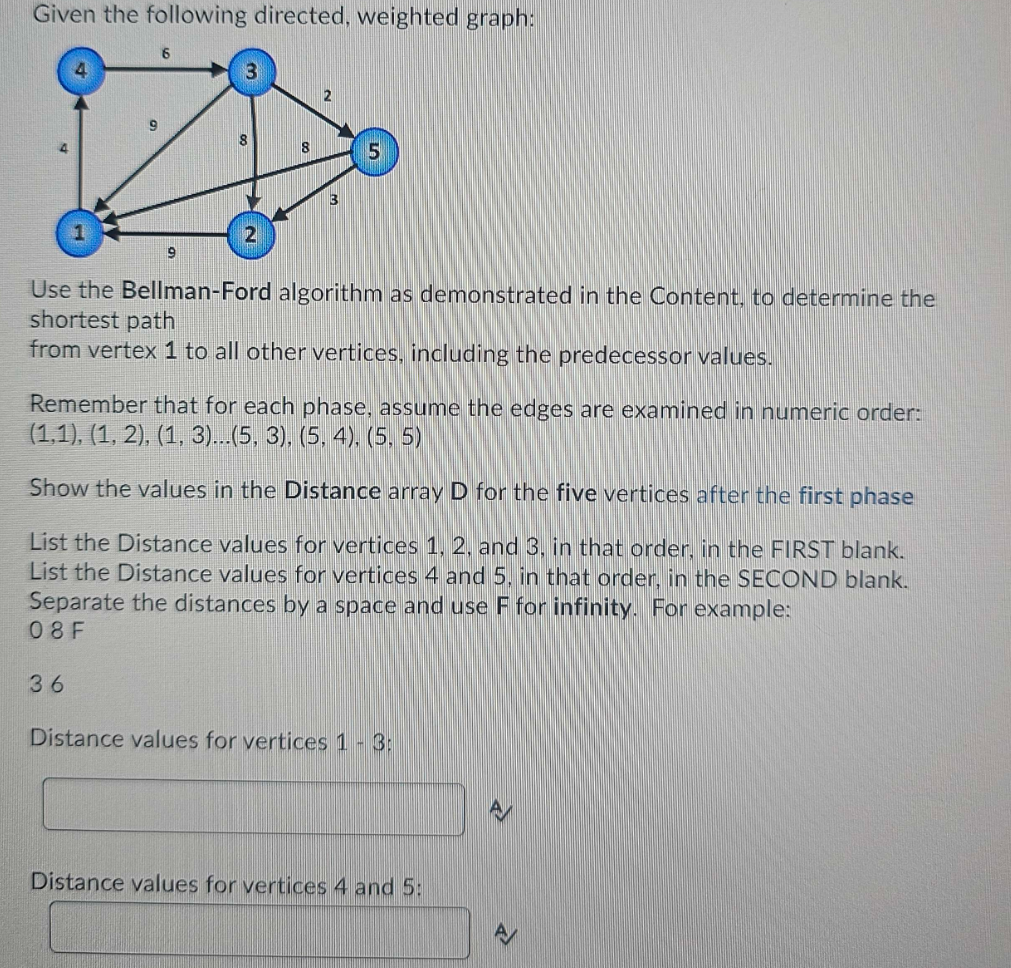Given the following directed, weighted graph: 9 6 36 9 3 2 8 3 5 Use the Bellman-Ford algorithm as demonstrated in the Content, to determine the shortest path from vertex 1 to all other vertices, including the predecessor values. Remember that for each phase, assume the edges are examined in numeric order: (1,1), (1, 2), (1, 3)...(5, 3), (5, 4), (5, 5) Show the values in the Distance array D for the five vertices after the first phase List the Distance values for vertices 1, 2, and 3, in that order, in the FIRST blank. List the Distance values for vertices 4 and 5. in that order, in the SECOND blank. Separate the distances by a space and use F for infinity. For example: 08 F Distance values for vertices 1 - 3: Distance values for vertices 4 and 5: >
Given the following directed, weighted graph: 9 6 36 9 3 2 8 3 5 Use the Bellman-Ford algorithm as demonstrated in the Content, to determine the shortest path from vertex 1 to all other vertices, including the predecessor values. Remember that for each phase, assume the edges are examined in numeric order: (1,1), (1, 2), (1, 3)...(5, 3), (5, 4), (5, 5) Show the values in the Distance array D for the five vertices after the first phase List the Distance values for vertices 1, 2, and 3, in that order, in the FIRST blank. List the Distance values for vertices 4 and 5. in that order, in the SECOND blank. Separate the distances by a space and use F for infinity. For example: 08 F Distance values for vertices 1 - 3: Distance values for vertices 4 and 5: >
Related questions
Question

Transcribed Image Text:Given the following directed, weighted graph:
9
6
36
9
3
2
8
3
5
Use the Bellman-Ford algorithm as demonstrated in the Content, to determine the
shortest path
from vertex 1 to all other vertices, including the predecessor values.
Remember that for each phase, assume the edges are examined in numeric order:
(1,1), (1, 2), (1, 3)...(5, 3), (5, 4), (5, 5)
Show the values in the Distance array D for the five vertices after the first phase
List the Distance values for vertices 1, 2, and 3, in that order, in the FIRST blank.
List the Distance values for vertices 4 and 5. in that order, in the SECOND blank.
Separate the distances by a space and use F for infinity. For example:
08 F
Distance values for vertices 1 - 3:
Distance values for vertices 4 and 5:
>
Expert Solution
This question has been solved!
Explore an expertly crafted, step-by-step solution for a thorough understanding of key concepts.
This is a popular solution!
Trending now
This is a popular solution!
Step by step
Solved in 3 steps
